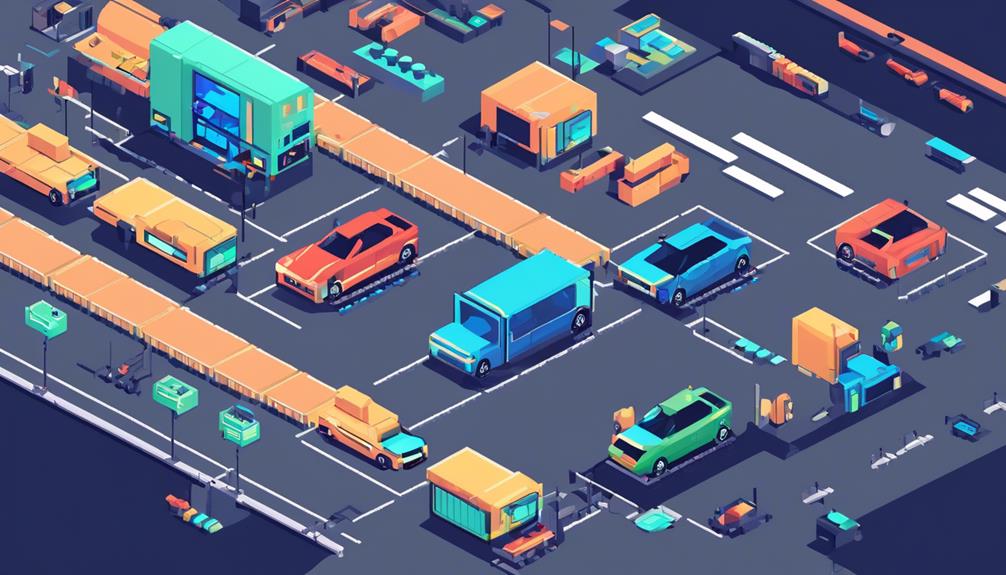As the automotive industry continues to push the boundaries of autonomous driving technology, the role of edge computing hardware becomes increasingly crucial.
The deployment of edge computing resources in autonomous vehicles allows for real-time data processing, reducing latency and improving response time. This, in turn, enhances the accuracy and reliability of data analysis and enables instant reactions to changing road conditions.
But what exactly is edge computing hardware, and how does it facilitate the implementation of AI algorithms in autonomous vehicles?
In this discussion, we will explore the importance of edge hardware, its role in vehicle autonomy, and the benefits it brings to the field of autonomous driving.
Key Takeaways
- Edge computing hardware is crucial for enabling real-time data processing and analysis in autonomous vehicles.
- It improves response time and reduces latency, allowing for split-second decision-making.
- Edge hardware enhances data security by processing data locally, reducing reliance on centralized data centers and cloud computing.
- It enables continuous functionality in areas with poor network connectivity, ensuring the autonomous driving system operates smoothly.
Edge Computing for Autonomous Vehicles

Edge computing is a critical component in the implementation of AI and machine learning algorithms within autonomous vehicles, enabling real-time data processing and analysis while reducing the need for centralized cloud-based processing. In the automotive industry, the deployment of edge computing has become increasingly important as connected cars rely heavily on the processing of vast amounts of data generated by various sensors.
One of the key advantages of edge computing in autonomous vehicles is its ability to perform real-time data processing. By bringing the computing power closer to the source of data generation, edge computing reduces latency and improves response time. This is crucial for autonomous vehicles, where split-second decisions need to be made based on the analysis of sensor data. Additionally, edge computing enhances data security by minimizing the need for data transmission to a central cloud, reducing the risk of cyberattacks and ensuring data privacy.
Edge computing also offers cost-effective solutions for autonomous vehicles. By processing data locally, it reduces the reliance on expensive data transmission to centralized cloud servers. This not only reduces operational costs but also enhances the overall data processing capabilities of the vehicle. With an in-vehicle edge computing system, autonomous vehicles can perform complex algorithms and analysis without the need for constant connectivity to the cloud.
Furthermore, edge computing enables various applications in autonomous vehicles, such as predictive maintenance and personalized infotainment. By processing sensor data in real-time, edge computing can identify potential maintenance issues and provide proactive solutions before they become critical. Additionally, edge computing allows for personalized infotainment services tailored to the preferences of passengers, enhancing the overall user experience.
Importance of Edge Hardware in Autonomous Vehicles
The implementation of edge computing in autonomous vehicles relies heavily on the utilization of specialized hardware that enables real-time data processing and analysis at the source, enhancing response time and data security. Edge hardware plays a crucial role in ensuring the efficient operation of autonomous vehicles by processing and analyzing data locally, reducing reliance on centralized data centers and cloud computing.
One of the key benefits of edge hardware is its ability to improve response time and reduce latency. By processing data at the edge, autonomous vehicles can quickly analyze sensor data and make real-time decisions. This is especially important in scenarios where milliseconds can make a significant difference, such as in avoiding collisions or adapting to changes in traffic flow. With edge hardware, autonomous vehicles can achieve faster reactions and enhance overall safety.
Edge hardware also enhances data security in autonomous vehicles. By processing and analyzing data closer to the source, edge computing reduces the risk of data breaches. Instead of transmitting large amounts of raw data to centralized servers for processing, edge hardware allows for the extraction of relevant information at the edge. This not only protects sensitive data but also reduces the amount of data that needs to be transmitted, improving bandwidth efficiency.
Furthermore, edge hardware enables autonomous vehicles to operate effectively in areas with poor network connectivity. By having the necessary processing power at the edge, connected vehicles can continue functioning even when there is limited or intermittent network access. This ensures continuous availability and functionality, regardless of the network conditions.
Role of Edge Computing in Vehicle Autonomy

Edge computing plays a pivotal role in enabling real-time data processing and decision-making in autonomous vehicles. With the increasing adoption of autonomous driving applications and the rise of connected road cars, the need for efficient and rapid data processing has become crucial. Edge computing brings processing power and intelligence closer to the source of data generation, reducing latency and improving the overall performance of the autonomous driving system.
One of the key advantages of edge computing in vehicle autonomy is its ability to handle the massive amount of data generated by the sensors in self-driving cars. These sensors capture a wide array of information, including images, videos, and sensor readings, which need to be processed in real-time for accurate decision-making. By processing this data at the edge, near the source, edge computing reduces the burden on centralized data centers and enables faster and more efficient processing.
To better understand the role of edge computing in vehicle autonomy, let's take a look at the following table:
| Traditional Data Processing | Edge Computing |
|---|---|
| Centralized data centers | Edge computing facilities near the source of data |
| Latency due to data transfer | Reduced latency, enabling real-time decision-making |
| Longer deployment time | Rapid deployment of edge computing facilities |
| Increased traffic on networks | Reduced network traffic and improved efficiency |
As seen in the table, the adoption of edge computing in autonomous vehicles brings several benefits. It not only reduces latency and enables real-time decision-making but also improves the overall efficiency of the autonomous driving system. By processing data at the edge, near the source, edge computing helps in reducing network traffic and minimizing the strain on centralized data centers.
Edge Computing Solutions for Autonomous Vehicles
With the increasing demand for efficient data processing and analysis in autonomous vehicles, the development of edge computing solutions has become crucial to meet the real-time processing needs of these vehicles. Edge computing enables autonomous vehicles to process and analyze data locally, reducing the reliance on cloud-based processing and minimizing data transmission latency.
Autonomous vehicles generate vast amounts of data from various sources, including sensors, connected road cars, and V2X communications. Edge computing allows this data to be processed at the edge of the network, closer to the source, ensuring faster response times and reducing the burden on the centralized cloud infrastructure.
One of the key advantages of edge computing in autonomous vehicles is its ability to handle real-time data processing. The immediate processing of sensor data and AI algorithms plays a critical role in enabling these vehicles to make split-second decisions. By leveraging edge computing, autonomous vehicles can analyze data in real-time, enhancing their ability to navigate complex environments and respond to changing road conditions.
Furthermore, edge computing enhances data security by processing and analyzing data locally. This reduces the risk of data breaches and ensures that sensitive information is not transmitted over the network. With the increasing concerns about data privacy and security, edge computing provides a more secure and reliable solution for processing data in autonomous vehicles.
Benefits of Edge Hardware in Autonomous Driving

Edge hardware in autonomous driving offers several significant benefits. One of the main advantages is enhanced computational capabilities and improved real-time data processing. By processing and analyzing data locally, edge computing enables real-time data processing, which is crucial for autonomous driving. Connected road cars equipped with edge hardware can rapidly deploy sensors to gather data on road conditions, analyze it in real-time, and make informed decisions.
Furthermore, edge computing improves data security in autonomous vehicles. By processing and analyzing data locally, the risk of data breaches is reduced. Sensitive information does not need to be transmitted to a central cloud for analysis, ensuring that data remains secure and protected. This enhances the overall safety of autonomous driving systems.
In addition to its benefits in data processing and security, edge computing is also cost-effective for the autonomous driving industry. By reducing the need for data transfer to a central cloud, edge hardware reduces the costs associated with data transmission. This cost-effectiveness makes edge computing an attractive solution for autonomous vehicles, enabling efficient data analysis while minimizing expenses.
Moreover, edge computing enhances the efficiency of data processing and analysis in autonomous vehicles. By enabling more efficient use of computing resources, edge hardware increases data processing capabilities. This improved efficiency translates into enhanced safety, efficiency, and reliability of autonomous driving systems. They can handle the large amount of data generated by sensors and machine learning algorithms more effectively.
Frequently Asked Questions
How Is Edge Computing Used in Autonomous Vehicles?
Edge computing is widely used in autonomous vehicles to enable real-time data processing and analysis, enhancing their efficiency and safety. By processing data locally, edge computing reduces reliance on centralized data centers and cloud computing, thereby decreasing latency and bandwidth requirements.
This technology also plays a crucial role in decision-making processes, as it enables the implementation of AI and machine learning algorithms. Moreover, edge computing enhances data security by minimizing the risk of data breaches.
Are Edge Devices Autonomous?
Yes, edge devices are capable of autonomous operation. They are designed to process and analyze data locally, making instant decisions without the need for communication latency. While edge devices have lower processing power compared to data centers, they excel in localized data processing and analysis.
In the context of edge computing, they play a crucial role in various industries such as:
- Smart cities
- Healthcare
- Industrial automation
- IoT
- Real-time analytics
- Retail
- Video surveillance
- Agricultural technology
- Energy management.
What Hardware Is in Self-Driving Cars?
The hardware in self-driving cars plays a critical role in enabling their autonomous capabilities. It includes sensors such as cameras, radar, Lidar, and thermal cameras, which gather data for real-time processing.
The processing power of the hardware is important for running complex algorithms and making real-time decisions. Data storage is necessary for storing and accessing the vast amounts of data collected by the sensors.
Connectivity requirements ensure seamless communication with other vehicles and infrastructure. Artificial intelligence integration enhances the car's ability to understand and respond to its environment.
Redundancy and fail-safe mechanisms are essential for ensuring safety and reliability. Sensor fusion techniques combine data from multiple sensors to create a comprehensive understanding of the surroundings.
Cybersecurity considerations are crucial to protect against potential threats. Human-machine interface design ensures intuitive and effective interaction between the car and its occupants.
What Is Edge Computing in Automotive Industry?
Edge computing in the automotive industry offers several advantages. It provides reduced latency, improved response time, and increased data security.
It plays a crucial role in real-time data processing for self-driving cars. This enables faster decision-making and enhances overall performance and efficiency.
Compared to cloud computing, edge computing provides faster and more reliable data processing. It is especially beneficial in situations where low latency is critical.
However, implementing edge computing for autonomous vehicles faces challenges. One challenge is the limited computing resources available. Another challenge is the need to address security considerations.
Despite these challenges, the future prospects of edge computing in the automotive sector are promising. It has the potential to enhance safety and integrate AI algorithms.
